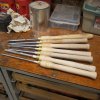Odie
Panning for Montana gold, with Betsy, the mule!
Henry Taylor makes fine bowl gouges......but, those big fat long handles are not for me! At 5"9", I'm not that big a man, and my hands/fingers are average size for my height. The width of the handle near the end is just too big around for comfortable tool work, and I've been living with them for years......until a week, or so, ago! They now have nice contoured shape that works much better for my style of tool control, IMHO.
The length would be ok, if I had a larger swing than 16", but as it is, the Henry Taylor 17" handles are a little too long for interior work.......they often hit on the bedways, and I'm unable to get the angle I'd prefer to be using.
The solution hit me the other day........put the round steel of the gouge into a chuck and the butt end into a revolving center.......cut and shape to my liking! These handles already have a center mark from when they were originally made.......easy to find the center on the butt end.
For 1/2" diameter, or smaller, the steel slips into the hollow spindle fine, past the chuck, and the chuck can be installed on the ferrel. Larger than 1/2" diameter can be chucked on the steel itself. (Careful to not thrust larger gouges into the No.2 MT, or damage can result, but >1/2" will slip right into the hollow spindle past the Morse Taper.
I don't think I spent more than about 10 minutes apiece to shape and shorten any of this batch of 6 gouges.......real easy to do. Didn't even bother to put a finish on them.....bare wood works for me, and I'm really not into the looks of them, just the utility.
......and, now I'm much happier with these......You could say they are custom made just for me! :cool2:
For me, 13 1/2" in length is just about right.
There will probably be those who will say to just make my own handles from scratch......that's a good suggestion, but I've got a whole bunch of them already handled.....so, this is a solution to my particular circumstances.
In the pic, the one at the top is unmodified for comparison.....the other six are done up to my liking.......
ooc
The length would be ok, if I had a larger swing than 16", but as it is, the Henry Taylor 17" handles are a little too long for interior work.......they often hit on the bedways, and I'm unable to get the angle I'd prefer to be using.
The solution hit me the other day........put the round steel of the gouge into a chuck and the butt end into a revolving center.......cut and shape to my liking! These handles already have a center mark from when they were originally made.......easy to find the center on the butt end.
For 1/2" diameter, or smaller, the steel slips into the hollow spindle fine, past the chuck, and the chuck can be installed on the ferrel. Larger than 1/2" diameter can be chucked on the steel itself. (Careful to not thrust larger gouges into the No.2 MT, or damage can result, but >1/2" will slip right into the hollow spindle past the Morse Taper.
I don't think I spent more than about 10 minutes apiece to shape and shorten any of this batch of 6 gouges.......real easy to do. Didn't even bother to put a finish on them.....bare wood works for me, and I'm really not into the looks of them, just the utility.
......and, now I'm much happier with these......You could say they are custom made just for me! :cool2:
For me, 13 1/2" in length is just about right.
There will probably be those who will say to just make my own handles from scratch......that's a good suggestion, but I've got a whole bunch of them already handled.....so, this is a solution to my particular circumstances.
In the pic, the one at the top is unmodified for comparison.....the other six are done up to my liking.......
ooc


